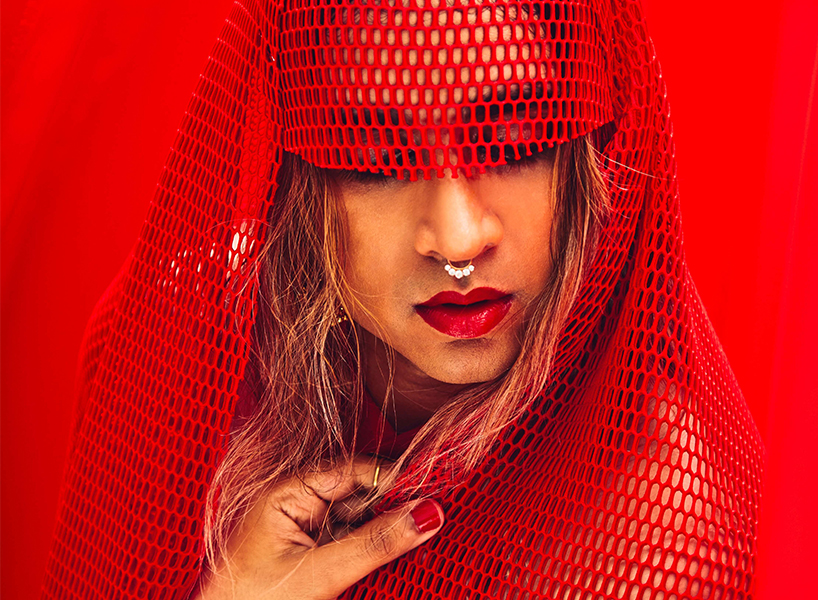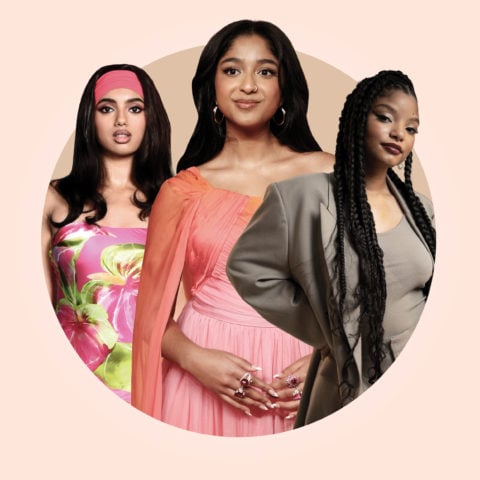I Used to Hide My Shalwar Kameez in Suitcases—and Now I Can Buy Them at Walmart
South Asian fashion, once confined to community gatherings, Bollywood and crowds at Coachella, is now more visible than ever.


In Karachi, Pakistan, where I grew up until the age of 9, Bollywood films and shaadis were the ultimate fashion flex. There was always a riot of colour and plenty of flash, but for me South Asian fashion went beyond films and family functions. Pakistanis wore shalwar kameez the same way Canadians wear jeans and a T-shirt. These clothes—dressed up or down—were simply a normal part of my life.
Then when I moved to Toronto, my world abruptly became monochromatic. I pared my wardrobe back to basics like sweaters my parents would buy me from Sears or beige khakis that looked better in a Gap ad than they did on me. Any traditional Pakistani clothes went to the back of my closet, reserved strictly for cultural occasions like Eid. For my parents, dressing up in lehengas, shalwar kameez and ghararas provided a sense of normalcy and continuity in a foreign place. For me, the thought of going out in public dressed in full Pakistani garb was nothing short of mortifying—so, for a long time, my M.O. was to pick clothes that would help me fit in, not stand out.
Now in my early 30s, I’ve learned to embrace all the things that make me who I am, including my rich cultural heritage. I can wear a shalwar kameez to a non-South Asian event without feeling ill-at-ease because I don’t feel compelled to conform or camouflage the parts of me that are different. I even share my mom’s love of visiting fabric shops and working with a seamstress to create custom lehenga pieces. I wear both South Asian and Canadian fashion proudly, but not just because I’ve matured and am more comfortable in my own skin. It’s helped that South Asian fashion, once confined to community gatherings, Bollywood and crowds at Coachella, is now more visible than ever.
Making South Asian fashion more visible
The perception of South Asian fashion in the mainstream—which once stretched only to extravagant weddings and colourful dance routines—is slowly changing thanks to fashion designers in the diaspora, like Brampton, Ont.’s Mani Jassal. My first visit to the Indo-Canadian designer’s original showroom in 2016 was nothing short of magical. Here was someone who was creating unbelievably beautiful and compulsively wearable clothes that showed off South Asian fashion in a fresh and exciting way.
https://www.instagram.com/p/Be9Ty-ohfWU/
Jassal’s designs paid homage to traditional silhouettes like lehengas, but gave them a twist with asymmetrical cut-outs and sassy thigh-high slits. She used familiar embroidery and beadwork, but showed them off on unexpected pieces like duster coats. When I attended her spring 2019 show at Toronto Fashion Week last year, surrounded by people who both looked like me and didn’t, it felt like sharing a secret with my best friends. I felt my heart swell up with pride as I watched the audience admire each piece as it came down the runway.
It’s no surprise that Jassal’s modern take on Indian fashion has endeared her to people both in and outside the South Asian community. She excels at bridal, but it’s just one part of the business, which boasts a diverse clientele, including celebrities like Ashanti and Bebe Rexha. Mani’s widely beloved label is an important change in how South Asian fashion has been represented in the mainstream. Instead of Gwen Stefani in a bindi or Gucci trying to treat turbans like a trend, for example, you have an actual Indian woman sharing South Asian fashion with the world.
“I design clothes for everyone and any woman that feels confident enough to be wearing the pieces,” says Jassal. “Just because I’m an Indian designer doesn’t mean I want to be pigeon-holed to one market only. How are you supposed to succeed, expand and globalize like that?”
https://www.instagram.com/p/BERU_Z4Ilbf/
Vancouver South Asian Fashion Week co-founders Cindy Khella and Farah Hassan have a similar mission, working to show people that South Asian fashion isn’t limited to Bollywood and bridalwear. “The perception of South Asian fashion is rapidly changing,” says Hassan. “There was a time when in general only sarees and traditional lehengas were considered South Asian fashion, but now we can see more modern versions of South Asian outfits with contemporary styling.”
https://www.instagram.com/p/BvYP7AnA51n/
A more modern approach to styling has helped make clothing more wearable outside of special occasions. “At South Asian Fashion Week, we have noticed guests and consumers are always inquiring about how to have multiple uses for South Asian pieces,” says Hassan. Jassal agrees, explaining that she’ll often walk her clients through various ways to wear her clothing whether it’s pairing a duster coat with jeans or a lehenga skirt with a leather belt.
Similarly, Sandy Gill—a fashion influencer and stylist known as The Sandy Lion, who has worked with everyone from Lilly Singh to Hasan Minhaj—matches South Asian and Western pieces in her everyday wardrobe. “It brings a little bit of our identity and our heritage into the look and I think it’s a beautiful fusion. It represents both parts of who we are.” You can find her sporting a lehenga skirt with a T-shirt (or a Raptors jersey), or incorporating Indian jewellery or a bindi into her look. The latter is the easiest and her favourite styling trick: “It’s so loud and colourful and iconic.”
https://www.instagram.com/p/Bx0AnX6Jlyh/
Even major retailers like Walmart Canada are buying into South Asian fashion as a growing market, making garments—once confined to ethnic enclaves or ordered from relatives making a trip to the motherland—more accessible in Canada. This February, it debuted fashion label All About You with actor Deepika Padukone, who is a massive star in India and recently appeared in xXx:Return of Xander Cage, as the face of the brand. The collection’s presence signals the growing trend of no longer being limited in where you buy your clothes.
https://www.instagram.com/p/BvUXg-jlJEX/
Fighting stereotypes
It’s not surprising that the growing prominence of South Asian fashion coincides with South Asians like Jassal wanting to take control of the narrative to address stereotypes about their culture. Hatecopy founder Maria Qamar’s pop art, for example, responds to the fetishization of South Asian culture, which she’s also translated into clothes. The Pakistani Martha Stewart’s Saher Sohail has turned her wry observations on the South Asian experience via drawing into wearable art with T-shirts like “Dulhania Dulha Le Jayegi” that reverse the roles in the iconic film, Dilwale Dulhania Le Jayegi with the bride whisking the groom away.
Likewise, the rise in visibility for South Asian fashion isn’t merely a product of the second and third generation grappling with issues of identity. Fashioning Diaspora: Beauty, Femininity, and South Asian American Culture author Vanita Reddy says that it reflects a larger push by society that wants to be seen as tolerant and inclusive.
“It’s often a way of embracing these forms of difference through fashion and cultural commodities like food and saying, ‘We embrace diversity as a nation. We’re not xenophobic. We’re not Islamophobic. If we were, we wouldn’t be wearing these clothes, we wouldn’t be interested these cultural forms,’” says Reddy, an associate professor at Texas A&M University.
She notes, however, that the rise of South Asian fashion doesn’t necessarily shift how people perceive or treat South Asian people. She notes that in post-9/11 when there was a sharp increase in Islamophobia, bell-dancing and South Asian fashion became more popular. “You can be vilified and celebrated at the very same time,” she says.
There’s also the issue of being excoticized. Jassal, for example, continues to get comments about her “exotic” collections from people who visit her downtown Toronto showroom. “I’ve had white people come in and say that it looks like a museum in here,” says Jassal. “You wouldn’t say that if it was someone selling [western-style] dresses.” Jassal adds she’s also gotten comments like, “You wear crop tops? I thought that wasn’t allowed.”
“I had one lady come in and say, ‘Oh, this is Indian? It’s not for me.’ She didn’t even give me a chance to explain who I am as a designer,” says Jassal.
Still, she believes that in the long run, she can use her label to help challenge existing perceptions. “It’s about educating people,” says Jassal. “I’m glad I’m able to teach people that Indian fashion is more than just sarees because there’s always that stereotypical notion of what it is.”
The role of the Internet and social media

The Internet has played a major role in helping the South Asian diaspora connect with its roots. “What’s helped for me, aside from confidence is getting older and not caring as much, is following a wide range of South Asians on social media who are visual artists and influencers—and necessary people in fashion—and seeing the way they carry their culture into their aesthetic,” says multi-disciplinary artist Vivek Shraya, who often incorporates South Asian fashion into her own style, as seen in her recent M.A.C Cosmetics campaign. “Having a feed that features people like Kay Ray and Avan Jogia, even Rajni Perera, seeing other South Asian people embrace their culture, and having access to that kind of representation has given me a lot of confidence to own Indian fashion.”
It’s a stark contrast to what it felt like growing up when we didn’t have Instagram to connect us with others just like us. “I remember in the ’90s when Madonna was doing her South Asian phase,” says Shraya. “A lot of people have been very critical of her for being appropriative but as a brown kid in Edmonton, that felt like representation to me. I was finally seeing things from my culture being adopted into popular culture. That’s all I had—Madonna’s Indian phase. Twenty years later, it’s so nice to see Indian culture and aesthetic from actual South Asian people and diasporic South Asian people as well.”
My own fashion heroes have evolved as I’ve gotten older, thanks in no small part to the Internet and social media. I love Élan as much as I love Erdem, and covet a couture creation by Sabyasachi as much as Chanel. And my taste in fashion and style are all the richer for it.
Jassal told me about a meme: the white girl who would make fun of you for your yellow rice and yellow curry is now the same girl is putting turmeric in her food because it’s vegan and healthy. It’s just as easily applicable to fashion. I once cared what girls like that thought and what they might consider cool, but not anymore. Every time I put on a shalwar kameez or wrap a dupatta around myself, I’m reminded of where I come from and everything my parents left behind when we moved from Pakistan. These garments are so much more than just clothes—and hiding them would be like hiding a part of myself.








